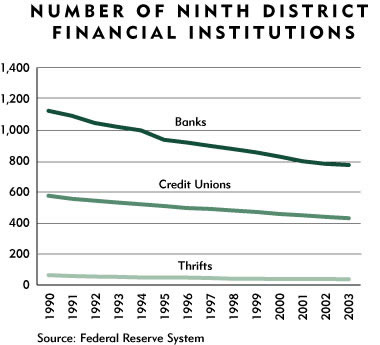The commercial banking industry is no stranger to volatility, but you have to go back quite a way to see a similar drop in their numbers.
Starting in the early 1920s, the number of commercial banks plummeted from a peak of about 30,000 to just 14,000 by 1934, thanks mostly to the Great Depression. For the next 50 years, their numbers remained virtually unchanged, rising just slightly to a post-Depression peak of 14,500 by 1984, according to the Federal Deposit Insurance Corp. (FDIC). Over the last two decades, that number has been cut to roughly 7,700.
But banks are not the only segment of the financial industry feeling the pressure of consolidation. Other regulated depository institutions—credit unions, savings and loans, and savings banks—are facing the same forces that are reshaping commercial banking and have seen a similar steep drop in numbers.
According to the Office of Thrift Supervision, which regulates savings banks and savings and loan firms (also known as thrifts), this segment is on a much faster pace of decline than commercial banks. Nationwide, the number of thrifts has been cut in half since 1992 to just over 900 today—that from a peak of about 4,500 in the mid-1960s. Currently, thrifts make up only about 7 percent of all FDIC-insured banks.
Credit union numbers are also on a downward slope, declining nationally by about one-third since 1990, compared with a 37 percent decline for commercial banks. Credit unions also fared better in the district, seeing a decline of about 25 percent, compared with 31 percent for district commercial banks. Still, the number of credit unions in Wisconsin recently dropped below 300, a level not seen since the 1930s.
Like commercial banks, the drop among other depository institutions has affected small firms the most. Virtually all of the loss in credit unions can be traced to credit unions with less than $10 million in assets, according to the National Credit Union Administration. (Credit unions are generally smaller. A very large credit union is one with $500 million in assets; a very large bank has about five times that amount, and a number have 200 times that amount.) Unlike banks and credit unions, thrifts have been in decline virtually across the board; even the largest class of thrifts ($5 billion or more in assets) has fewer firms today than in 1988.
But also like commercial banks, lower numbers are the result of merged (not failed) firms, particularly in the case of credit unions. Over the last five calendar years, there has been an annual average of 300 mergers among credit unions nationwide, compared with an average of 26 involuntary liquidations and assisted mergers per year. During this period, credit union assets went up 50 percent to $600 billion.

|
Related articles: |
Ron Wirtz is a Minneapolis Fed regional outreach director. Ron tracks current business conditions, with a focus on employment and wages, construction, real estate, consumer spending, and tourism. In this role, he networks with businesses in the Bank’s six-state region and gives frequent speeches on economic conditions. Follow him on Twitter @RonWirtz.





